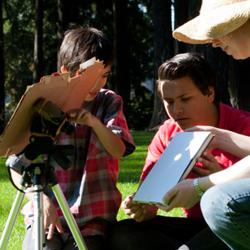Source Institutions
Source Institutions
Add to list Go to activity
Activity link broken? See if it's at the internet archive

In this activity, learners use binoculars (or a telescope) to identify and track sunspots. If using binoculars, learners need a pair that can be secured on a tripod. Specific information is also provided on the size of binoculars. At the end of the activity, learners have the option of comparing their conclusions with real time images of the Sun showing (or not showing) sunspots from NASA's Solar Dynamics Observatory satellite. Step-by-step instructions are included with photos. This activity needs a sunny day. Activity guide includes a "What's going on?" explanation and connections to relevant science concepts like sunspots, and the solar cycle with helpful diagrams and photos. Please note there may be no sunspots due to the current activity of the Sun.
- 5 to 10 minutes
- 10 to 30 minutes
- Over $20 per group of students
- Ages 8 - adult
- Activity
- English
Quick Guide
Materials List (per group of students)
- two sheets of bright white paper
- a book
- tape
- binoculars or telescope (specific sizes are listed)
- tripod
- pencil
- piece of cardboard- roughly 30cm x 30cm
- scissors
- thick piece of paper- roughly 10cm x 10cm (optional)
- rubber bands (optional)
Subjects
-
Earth and Space Science
- Astronomy
-
Solar System
- The Sun
-
Physical Sciences
-
Vibration and Waves
- Light and Optics
-
Vibration and Waves
Informal Categories
- Outdoor Activity
Audience
To use this activity, learners need to:
- see
Learning styles supported:
- Involves hands-on or lab activities
Other
This resource is part of:
Access Rights:
- Free access
By:
Source Collection
- DIY Science Apps
Rights:
- , The Regents of the University of California, 2014
